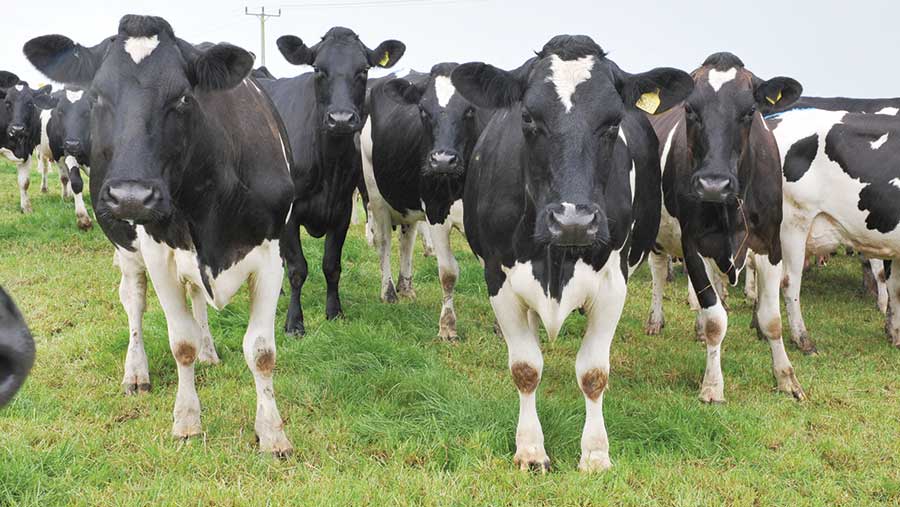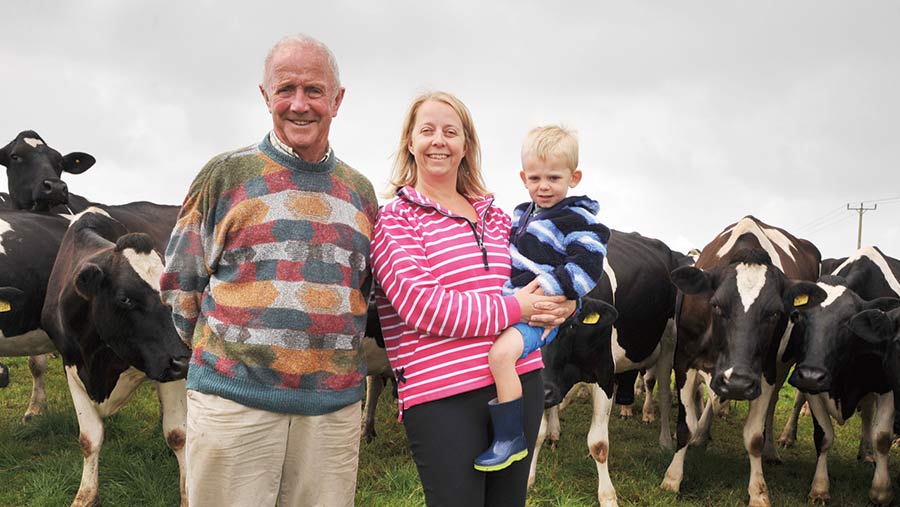How a Welsh dairy farm achieved BVD-free status
 The herd was vaccinated against BVD
The herd was vaccinated against BVD A herd on a south Wales farm has been accredited BVD-free for five years after embarking on a vaccination programme.
We visit the farm to find out how they beat the disease after finding evidence of BVD infection.
There were no obvious symptoms of BVD in the Evans family’s three dairy herds when an annual bulk milk tank test showed a high level on antibodies of the disease.
Stock bulls were the only animals bought in, so the infection was likely to have come from cattle that had strayed onto the farm.
The business is run by Iori and Heulwen Evans and Sian and Claudio Lima, their daughter and son-in-law.
See also: 1,000 herds now signed up to BVDFree
They milk 750 spring-calving British Friesian cows on 480ha on three adjoining farms – Parc-Cynog, Colston and Great Capthorne, near Pendine.
With evidence of BVD infection, the farm’s vet, David Staak of Market Hall Vets, St Clears, advised vaccinating the whole herd.

Iori Evans, pictured with his daughter and grandson, Ogwen and Jessie Williams
Working towards BVD-free accreditation
They vaccinated for three years and when the bulk milk sample tested clear, they embarked on a two-year programme to achieve BVD-free accreditation.
Bull calves are sold to local farmers and 220 heifer replacements are reared, with the surplus sold to private buyers.
There were obvious advantages to working towards accreditation, says Mrs Lima.
See also: Controlling BVD
“We felt it would give us peace of mind to know that we didn’t have BVD in the herd and it would also give our buyers a level of assurance.
“It seemed the right thing to do – to take a proactive approach – when it was obvious to us there would in future be an eradication plan.’’
They opted to join the SAC Veterinary Services’ accreditation scheme. To achieve certification, the herd had to undergo two years of bulk milk and youngstock blood testing and all samples had to be clear. It was also necessary for all stock, from the age of nine months, to be vaccinated.
Farm facts
- The herd calves between 20 March and the end of June
- Produces an average annual milk yield of 6,000 litres, at 2.94% protein and 4.21% butterfat, with milk sold to Müller Wiseman
- Cell counts average 202,000/ml and the bactoscan reading is 18
- The herd is also vaccinated against leptospirosis, IBR, husk, blackleg and salmonella
“Because we had been vaccinating for three years before starting the accreditation process the youngstock tested negative – the vaccine had taken effect in the cows and, as a result, the infection soon came under control,” Mr Staak explains.
“The process of accreditation normally takes about two years because the herd needs to be screened annually for any underlying infection. Because calves can only be tested from nine months of age, there is a bit of a lag.”
The recommendation is for samples to be taken from five animals in every youngstock group. With all heifers reared centrally – at Parc Cynnog – it was only necessary to test five animals.
These tests were negative. From that point, all youngstock, cows and bulls were vaccinated against BVD.
Maintaining BVD-free status
The herd has now been accredited free of BVD infection for five years.
To maintain that status, cows and youngstock are vaccinated once a year – in February, when they are housed and before calving gets under way. Before the vaccine is given, the herd is tested for signs of infection.
The vaccine costs about £5 an animal, but with losses estimated at £20-£80 a cow a year in herds where infection is present, Mrs Lima says it is money well spent.
The Evans family pay about £120 a year for the BVD blood sampling and laboratory testing. They also pay £78 in annual subscription to SAC Veterinary Services for the accreditation.
Mrs Lima says it is an investment worth making.
The most likely way for BVD to enter a herd is through purchased stock.
The only animals the Evanses buy are pedigree British Friesian bulls to sweep the herd after AI. These are bought from farms with a high herd health status and tested for BVD before they arrive on farm. “This helps keep infection out,” says Mr Staak.
For ease of calving, heifers are bred to Jersey bulls using AI.
As more herds become clear of infection, protection becomes easier because the risk of infection diminishes.
Mr Evans is confident that, if the industry works together, BVD can one day be eradicated from the national herd.
“We have managed to eradicate warble fly – there is no reason why we can’t achieve the same outcome with BVD.”
The new Welsh strategy
The Welsh government launched a £9m BVD eradication programme last month.
From September every herd in Wales will be offered blood tests during their TB tests and herds that test positive will receive £500 to identify persistently infected animals.
Mr Staak says BVD control and eradication is relevant to any farm, whether the disease is present or not.
“Even if a herd is not infected it needs to be protected, because if a herd that hasn’t previously been exposed to the disease becomes infected the consequences can be dire.”
For herds considering carrying out vaccination for the first time, Mr Staak says the timing is critical. “The vaccines produce BVD antibodies, so screening for infection should be done before vaccination,” says Mr Staak.
“The animals must also be at least nine months old when they are screened – old enough to not have maternally derived antibodies in their system.”
